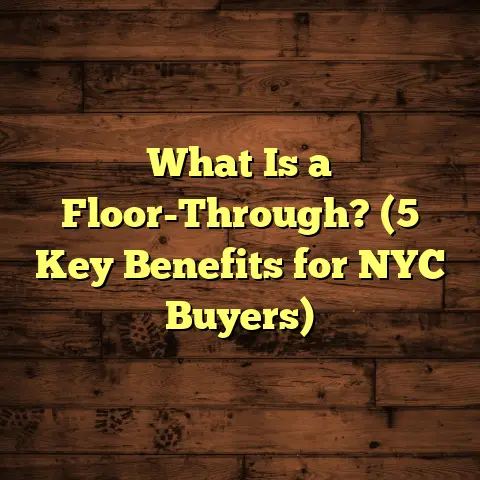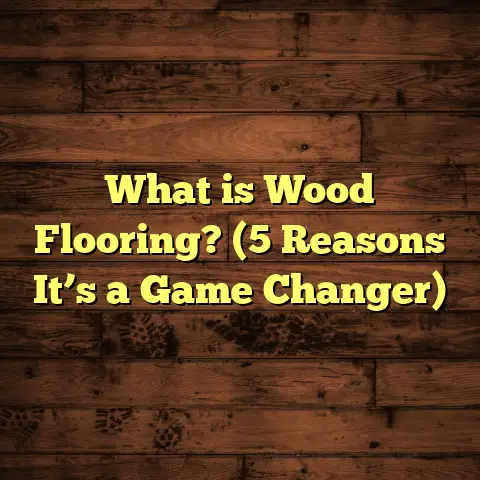What is Epoxy Terrazzo Flooring? (3 Benefits for Your Space)
I have a lively dog named Max who basically runs the show at home. He’s the kind of energetic pet that leaves muddy paw prints everywhere, scratches at the floor when excited, and occasionally spills his food and water. This made me rethink my floor choices—not just for looks but for something that could take the abuse without losing its charm. That’s how I first got interested in epoxy terrazzo flooring.
What Is Epoxy Terrazzo Flooring?
You might have seen terrazzo floors before—those smooth surfaces with speckles of marble or glass chips embedded in them. Epoxy terrazzo is a modern twist on this classic style. Instead of using cement as a base, epoxy terrazzo uses a synthetic resin binder called epoxy to hold the aggregates together.
This mixture cures into a hard, shiny surface that’s incredibly durable and seamless. The epoxy acts like a glue, bonding the marble or glass chips tightly and providing a smooth finish that can be polished to a high gloss.
Why epoxy? Well, traditional cement terrazzo floors are thick and require more time to install and cure. Epoxy terrazzo is thinner, lighter, and cures much faster—often within 24 to 48 hours. The resin also offers more flexibility in design because it can be tinted any color and mixed with various aggregates.
From my experience, this flooring style is great for anyone wanting something both decorative and tough.
Basic Composition
Epoxy terrazzo consists mainly of:
- Epoxy resin binder: A two-part mixture that hardens chemically.
- Aggregates: Crushed marble, quartz, glass chips, or even recycled materials.
- Primer: Applied on the subfloor for adhesion.
- Sealer: Protects the finished surface from stains and wear.
The exact mix varies depending on the design and performance needs.
Installation Thickness & Layers
Epoxy terrazzo usually requires a thickness of about 1/4 to 3/8 inch (6-9 mm). This is much thinner than cement terrazzo floors, which can be over 1 inch thick. The thinner layer means:
- Faster installation
- Less weight on subfloor structures
- Easier repairs if needed
My Introduction to Epoxy Terrazzo: Personal Story
When I was renovating my kitchen a few years ago, I wanted a floor that could handle high foot traffic and my dog’s antics. I initially considered hardwood or tile but worried about scratches and grout cleaning.
A contractor suggested epoxy terrazzo. I was skeptical at first—wasn’t terrazzo outdated? But after seeing samples and hearing about its durability and design options, I gave it a shot.
The installation took just three days. Max was curious during the process but didn’t bother the drying floors. Once complete, the floor had this glossy, colorful look with tiny flecks of white and gray marble chips embedded in blue epoxy.
Cleaning was a breeze compared to my previous tiles—no grout lines trapping dirt or stains. After a year of Max’s mud trails and spilled kibble, the floor still looks brand new. It’s been a game-changer for my home.
Why Epoxy Terrazzo? Three Benefits That Make It Worth Considering
Epoxy terrazzo has several benefits that make it stand out compared to other flooring types. Here are three that really matter if you’re thinking about your space:
1. Durability That Resists Wear & Tear
If you’ve ever owned pets or have kids running around, you know how quickly floors can show signs of damage. Scratches from claws, spills that stain, or cracks from dropped objects are common worries.
Epoxy terrazzo offers excellent resistance to these problems.
Hardness & Scratch Resistance
The cured epoxy resin forms an extremely hard surface. On the Mohs scale of hardness (which measures scratch resistance), epoxy terrazzo scores around 7 to 8. For comparison:
- Hardwood floors typically range between 3 and 5.
- Ceramic tiles are around 6 to 7.
- Concrete is about 5 to 7.
This means epoxy terrazzo is harder than many traditional materials, making it less prone to scratches from pet claws or dropped objects.
Impact & Crack Resistance
Because epoxy is slightly flexible compared to cement, it absorbs impacts better without cracking. This flexibility helps reduce repair costs and keeps the floor looking flawless longer.
Longevity Data
According to flooring industry reports, epoxy terrazzo floors last over 40 years with proper care. In contrast:
- Hardwood floors last about 15-20 years before refinishing or replacement.
- Laminate floors last 10-15 years.
- Tile floors can last 20-30 years but often need grout repair.
This longevity translates into savings over time because you avoid frequent repairs or replacements.
My Experience with Durability
Max once scratched near the kitchen door where he waits for me to come home. Instead of leaving marks like on my previous wooden floor, the epoxy terrazzo showed no visible damage. It’s like the floor laughs at scratches!
2. Simple Cleaning & Low Maintenance
I can’t stress enough how much easier cleaning is with epoxy terrazzo compared to other surfaces.
Non-Porous & Seamless Surface
Because there are no grout lines or seams where dirt can trap, sweeping and mopping are all you need most days. The non-porous nature means liquids don’t soak in; spills just sit on top until wiped away.
Time Savings
A study by the Flooring Contractors Association found that cleaning epoxy terrazzo floors takes about 30% less time annually compared to ceramic tile floors due to fewer grout lines and less scrubbing.
Chemical Resistance
Epoxy resin resists many household chemicals, so you don’t need harsh cleaners. Mild soaps or neutral pH solutions work perfectly without damaging the surface.
Odor & Allergen Control
For pet owners like me, this is key. Epoxy terrazzo doesn’t absorb odors like carpet or some wood finishes might. It also doesn’t harbor dust mites or allergens as carpets do, offering a cleaner environment.
Real-Life Cleaning Routine
After Max’s muddy walks, I simply sweep up loose dirt and mop with warm water and a mild detergent weekly. No stains, no discoloration, no fading after years of use.
3. Design Freedom & Visual Appeal
Epoxy terrazzo isn’t just functional—it allows you to express creativity with your floors in ways other materials can’t match.
Color Options
Epoxy resin can be dyed any color under sunlight-resistant pigments. Whether you want bold blues or subtle earth tones, you can get exactly what fits your style.
Aggregate Variety & Patterns
You can choose marble, glass chips, quartz, or even recycled materials as aggregates in different sizes and colors. These create unique textures and visual effects when polished.
Custom Logos & Artworks
One of my favorite projects was designing a custom floor with embedded logos for a company lobby. The epoxy allowed intricate shapes and colors that traditional flooring struggles with.
According to the Terrazzo & Mosaic Association survey:
- Over 70% of architects prefer epoxy terrazzo for its ability to blend durability with aesthetics.
- Custom designs in commercial spaces increased by 25% over five years due to this flexibility.
Polished Finish
The grinding and polishing phase reveals beautiful aggregates creating a smooth, reflective surface that brightens any room naturally.
My Design Journey
I initially chose blue epoxy with white marble chips because it reminded me of ocean waves—a calming vibe for my home. Over time, I’ve added area rugs that complement the colors perfectly without hiding the floor’s character.
How Epoxy Terrazzo Flooring Is Installed: A Step-by-Step Look
Understanding the installation process helped me appreciate why epoxy terrazzo costs more upfront but pays off long term.
Step 1: Subfloor Preparation
The concrete base must be clean, level, and free of cracks or moisture issues. Any imperfections here will show through later or cause problems with adhesion.
Step 2: Primer Application
A primer layer seals the concrete and improves bonding with the epoxy resin mixture.
Step 3: Mixing Aggregates & Epoxy Resin
The resin is mixed carefully with chosen aggregates according to design specifications.
Step 4: Spreading Mixture Over Floor
The mixture is poured and troweled out evenly across the entire floor area within working time (usually 30-60 minutes).
Step 5: Curing Time
The floor cures in controlled conditions for 24-48 hours depending on temperature/humidity.
Step 6: Grinding & Polishing
Diamond abrasives grind down the surface to expose aggregates evenly and create smoothness. Multiple polishing steps follow to achieve desired shine.
Step 7: Sealing
A protective sealer is applied to enhance durability against stains and spills.
Comparing Epoxy Terrazzo Flooring with Other Popular Options
Here’s how it stacks up against common floors:
| Flooring Type | Durability | Maintenance | Design Options | Cost Range (per sq.ft) |
|---|---|---|---|---|
| Epoxy Terrazzo | Very High | Low | Very High | $20 – $45 |
| Hardwood | Medium | Medium | Medium | $8 – $15 |
| Laminate | Low-Medium | Low | Medium | $2 – $8 |
| Ceramic Tile | High | Medium (grout) | Medium | $5 – $15 |
| Carpet | Low | High | Medium | $3 – $12 |
Cost Note: Epoxy terrazzo has higher upfront costs but longer lifespan reduces replacement expenses over decades.
Addressing Common Questions About Epoxy Terrazzo Flooring
Is Epoxy Terrazzo Slippery?
Good question! When polished, epoxy terrazzo can be slippery when wet. However, adding anti-slip additives or choosing a honed (matte) finish reduces this risk significantly.
In my home, I added anti-slip sealer near entrances and kitchen areas where spills happen often. It works well without compromising shine.
Can Epoxy Terrazzo Be Used Outdoors?
Typically no—epoxy resins degrade under UV exposure over time. For outdoor applications, cement-based terrazzo or other materials are better suited.
How Long Does Installation Take?
For an average residential room (~300 sq.ft), installation including curing usually takes about 3–5 days depending on site conditions.
Is It Environmentally Friendly?
Yes! Epoxy terrazzo often incorporates recycled glass or stone chips as aggregates. Plus, its long life reduces waste from replacements.
Case Study: Renovation of a Pet Shelter Using Epoxy Terrazzo
A local animal shelter faced flooring issues due to constant cleaning demands and heavy animal traffic. They opted for epoxy terrazzo because:
- It can withstand chemical disinfectants.
- Easy to clean animal hair and waste.
- Durable against claws and impacts.
- Custom colors brightened their space creating a welcoming environment for visitors.
After one year:
- Cleaning time dropped by 40%.
- Floor repairs were zero.
- Staff reported better comfort standing on smooth yet slightly cushioned surface.
- Animals had fewer slip-related accidents due to textured finish added during installation.
This practical example shows how epoxy terrazzo works well even in challenging environments.
Long-Term Care Tips and How to Keep Your Floor Looking New
Here’s what I recommend based on years of experience:
- Daily sweeping/vacuuming: Prevents abrasive grit from scratching.
- Weekly mopping: Use mild soap; avoid acidic or alkaline cleaners.
- Mats at entrances: Capture dirt before it reaches your floor.
- Avoid dragging heavy furniture: Use felt pads under legs.
- Periodic professional polishing: Every 5–7 years to restore shine.
- Sealer reapplication: Depending on traffic; usually every few years.
Following these steps makes your investment last decades without losing appeal.
Advanced Insights: Innovations in Epoxy Terrazzo Technology
Recent advances include:
- UV-stabilized resins: For limited outdoor use or UV-exposed interiors.
- Antimicrobial coatings: Helpful in healthcare or food prep areas.
- Eco-friendly resins: Bio-based epoxies reducing environmental impact.
- Enhanced slip resistance: Micro-textured finishes improving safety without dulling appearance.
Staying updated on these trends helps you choose the best option for your specific needs.
Budgeting Your Epoxy Terrazzo Project: What You Need To Know
Cost depends on:
- Floor size
- Aggregate choice
- Design complexity
- Subfloor condition
- Location/labor rates
On average:
- Materials range from $10-$25 per sq.ft
- Labor adds $10-$20 per sq.ft
- Complex designs increase total cost by up to 30%
Using tools like FloorTally helps get precise estimates by factoring local pricing and waste allowance.
Though pricier upfront than laminate or tile, think about lifetime value—maintenance savings + durability offset initial costs in less than 10 years for busy homes/businesses.
Final Thoughts: Would I Choose Epoxy Terrazzo Flooring Again?
Absolutely yes! Living with it daily has shown me its practical benefits beyond just looks:
- Stands up to pet wear & tear effortlessly
- Makes cleaning quick & simple
- Offers unique styles tailored exactly how I want them
- Adds lasting value to my home environment
If you want floors that combine beauty with toughness—especially when you have pets or kids—I highly recommend considering epoxy terrazzo flooring seriously.
Feel free to ask if you want help exploring designs or budgeting your project—I’ve learned quite a bit through trial and error!





